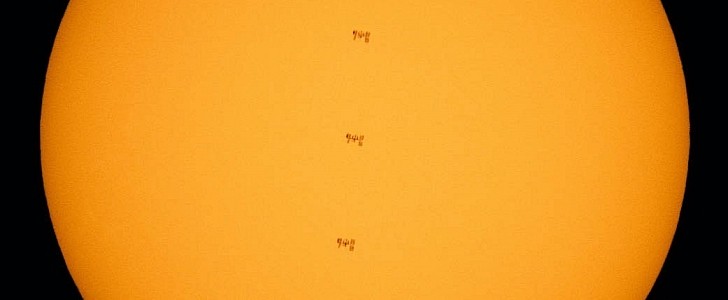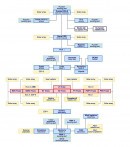It’s a very busy time up there in Earth orbit, where the seven astronauts onboard an orbiting laboratory are busy installing new solar arrays to cope with the increasing energy demands of the International Space Station. That requires both onboard activities and spacewalks.
On June 25, two of the astronauts, Shane Kimbrough and Thomas Pesquet, exited the station to install something NASA calls “the second Roll-Out Solar Array (iROSA) on the 4B power channel.” On the same day, while the astronauts were working outside the station, someone in Nellysford, Virginia, snapped some shots of the ISS as it was transiting the sun.
The seven frames were brought together in a composite image released on Monday, June 28, by the American space agency (click the main photo to enlarge). It shows the recognizable silhouette of the human-made object going north to south over the orange surface of the sun at five miles per second (8 km/second). Try as you might, you will not be able to see the two astronauts working to install the solar arrays.
As far as these bits of hardware are concerned, the new ones are being installed in front of six of the current arrays “and will use the existing sun tracking, power distribution, and channelization.” That means they’ll shade over half the length of the eight existing ones, which are capable of generating a combined 160 kilowatts of power during orbital daytime.
The new panels, developed by aerospace company Boeing, will add an extra 20 kilowatts of electricity each, for a total of 120 kilowatts, almost doubling the capacity of the existing hardware.
NASA says the “combination of the eight original, larger arrays, and the smaller, more efficient new arrays will restore the power generation of each augmented array to approximately the amount generated when the original arrays were first installed” more than a decade ago.
The seven frames were brought together in a composite image released on Monday, June 28, by the American space agency (click the main photo to enlarge). It shows the recognizable silhouette of the human-made object going north to south over the orange surface of the sun at five miles per second (8 km/second). Try as you might, you will not be able to see the two astronauts working to install the solar arrays.
As far as these bits of hardware are concerned, the new ones are being installed in front of six of the current arrays “and will use the existing sun tracking, power distribution, and channelization.” That means they’ll shade over half the length of the eight existing ones, which are capable of generating a combined 160 kilowatts of power during orbital daytime.
The new panels, developed by aerospace company Boeing, will add an extra 20 kilowatts of electricity each, for a total of 120 kilowatts, almost doubling the capacity of the existing hardware.
NASA says the “combination of the eight original, larger arrays, and the smaller, more efficient new arrays will restore the power generation of each augmented array to approximately the amount generated when the original arrays were first installed” more than a decade ago.











